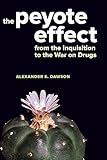The peyote effect : from the Inquisition to the War on Drugs / Alexander S. Dawson.
Material type: TextPublisher: Oakland, California : University of California Press, [2018]Copyright date: ©2018Description: 1 online resourceContent type:
TextPublisher: Oakland, California : University of California Press, [2018]Copyright date: ©2018Description: 1 online resourceContent type: - text
- computer
- online resource
- 9780520960909
- 0520960904
- Peyote -- Law and legislation -- United States
- Peyote -- Law and legislation -- Mexico
- Indians of North America -- Drug use
- Indians of North America -- Religion
- Indians of North America -- Social life and customs
- Mescaline
- Indians of North America
- Religion
- Mescaline
- Indians, North American
- Religion
- United States
- Mexico
- Mescaline
- Indiens d'Amérique -- Amérique du Nord
- Religion
- religion (discipline)
- POLITICAL SCIENCE -- Public Policy -- Social Security
- POLITICAL SCIENCE -- Public Policy -- Social Services & Welfare
- HISTORY -- Latin America -- Mexico
- Indians of North America -- Drug use
- Indians of North America -- Religion
- Indians of North America -- Social life and customs
- Mexico
- United States
- 362.29/308997 23
- RS165.P44 D39 2018
- QV 77.7
| Item type | Home library | Collection | Call number | Materials specified | Status | Date due | Barcode | |
|---|---|---|---|---|---|---|---|---|
 Electronic-Books
Electronic-Books
|
OPJGU Sonepat- Campus | E-Books EBSCO | Available |
Includes bibliographical references and index.
Introduction : 1833 : the cholera epidemic -- 1887 : Dr. John Briggs eats some peyote -- 1899 : The Instituto Médico Nacional -- 1909 : Poison -- 1917 : The ban -- 1918 : The Native American Church -- 1937 : The Goshute letter -- 1957 : The Holy Thursday experiment -- 1958 : Alfonso Fabila visits the Sierra Huichola -- 1964 : bona fide -- 1971 : Peyote outlawed in Mexico -- 1972 : The exemption -- 2011 : Tom Pinkson -- Conclusion : race, space, time.
"Banned by the Inquisition in 1620, peyote was implicated in over 80 religious trials during the colonial period. After four centuries of change, we have arrived at the beginning of the 21st century to a point where our laws concerning peyote resonate uncomfortably with the laws promulgated by the Spanish Inquisition. The justifications are different, and in part it seems like a quirk of history, this book pursues the question of whether laws the Mexican and US governments have created in the 20th and 21st centuries in some ways repeat a colonial tradition in which indigenous bodies were made incommensurable with non-indigenous bodies through the legal and social proscriptions enacted around peyote. The book seeks to understand how it was that peyote came to be so closely identified as an Indian thing even as other plants and animals native to the Americas lost their indigenous essence. In the final six chapters of the book we see how peyote was simultaneously embedded in four distinct phenomena: a taxonomic project concerned with making sense of psychedelic substances as drugs, a counter-cultural movement which saw in peyote an opportunity to embrace alternative forms of consciousness, a conservative movement that understood peyote as one of a number of existential threats to civilization, and burgeoning movements for indigenous self-determination that saw in peyote a powerful expression of indigenous alterity"--Provided by publisher.
Online resource; title from digital title page (viewed on October 03, 2018).
eBooks on EBSCOhost EBSCO eBook Subscription Academic Collection - Worldwide
There are no comments on this title.

